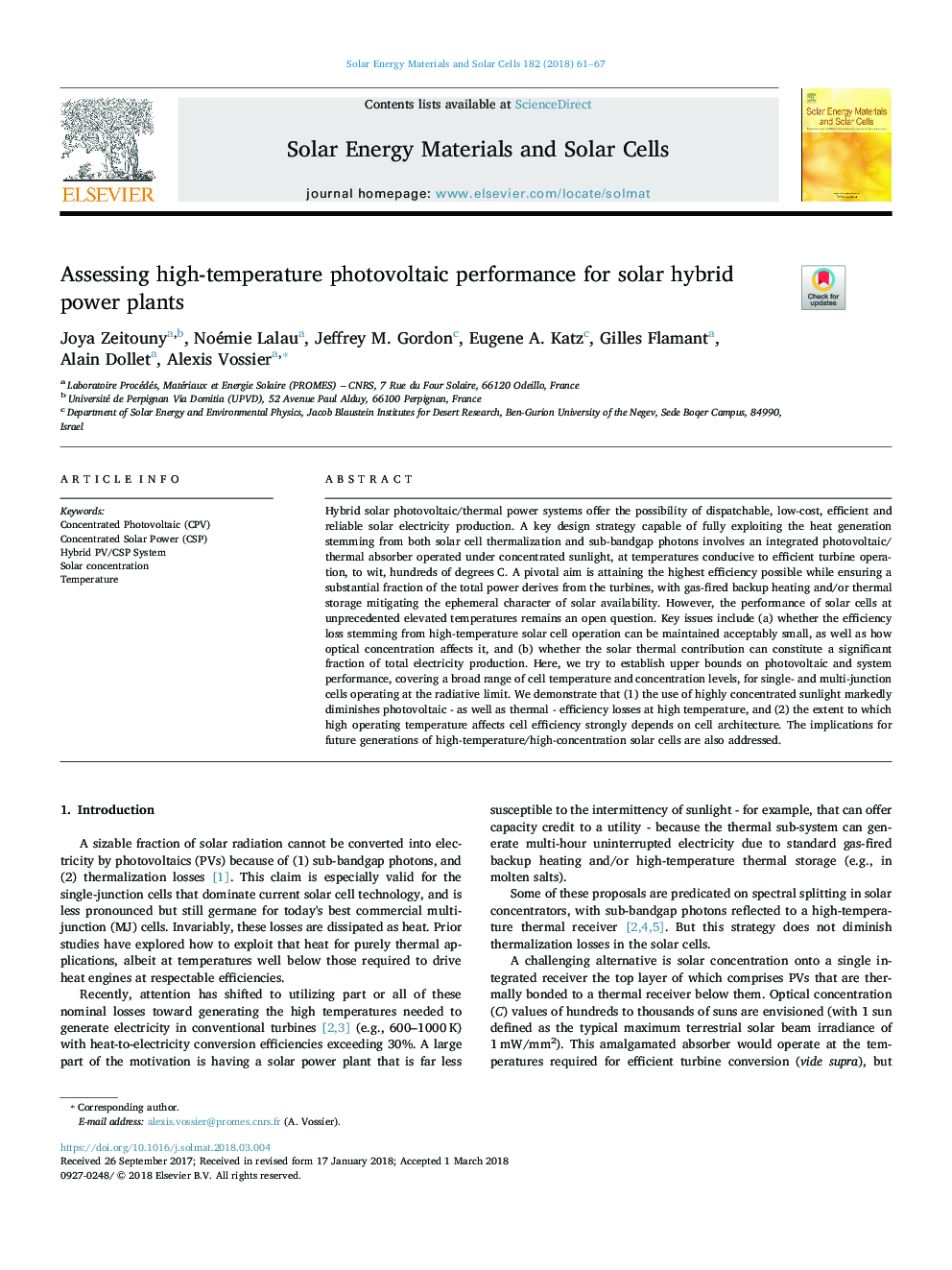| کد مقاله | کد نشریه | سال انتشار | مقاله انگلیسی | نسخه تمام متن |
|---|---|---|---|---|
| 6534112 | 1420641 | 2018 | 7 صفحه PDF | دانلود رایگان |
عنوان انگلیسی مقاله ISI
Assessing high-temperature photovoltaic performance for solar hybrid power plants
ترجمه فارسی عنوان
ارزیابی عملکرد فتوولتائیک درجه حرارت برای نیروگاه های هیبریدی خورشیدی
دانلود مقاله + سفارش ترجمه
دانلود مقاله ISI انگلیسی
رایگان برای ایرانیان
کلمات کلیدی
ترجمه چکیده
سیستم های هیبریدی خورشیدی فتوولتائیک / حرارتی امکان تولید برق خورشیدی را در اختیارتان، کم هزینه، کارآمد و قابل اطمینان قرار می دهد. استراتژی طراحی کلیدی که قادر است به طور کامل بهره برداری از تولید گرما از هر دو تثبیت سلول خورشیدی و فوتون های زیر باند گاز شامل جذب فتوولتائیک / حرارتی یکپارچه شده تحت نور خورشید متمرکز در دمای بالائی برای کارکرد توربین کارآمد به صدها درجه سانتیگراد است. هدف اصلی دستیابی به حداکثر کارآیی ممکن است در حالی که اطمینان از اینکه بخش قابل توجهی از کل انرژی از توربین ها تهیه می شود، با گرمایش تهویه مطبوع گاز و / یا ذخیره حرارتی کاهش می یابد و اثر کوتاه مدت خورشید در دسترس است. با این حال، عملکرد سلول های خورشیدی در دماهای بالا بی سابقه یک سوال باز است. مسائل کلیدی عبارتند از (الف) اینکه آیا از دست دادن کارایی حاصل از کارکرد سلول های خورشیدی با درجه حرارت بالا می توان به طور قابل توجهی کوچک نگهداری کرد و همچنین تاثیر متقابل نوری روی آن، و (ب) آیا سهم کل انرژی خورشیدی می تواند بخش قابل توجهی از کل برق باشد تولید در اینجا سعی می کنیم مرزهای بالاتری از عملکرد فتوولتائیک و سیستم را پوشش دهیم، دامنه وسیعی از دمای سلول و غلظت سلول ها را برای سلول های تک و چندتایی که در حد شعاعی عمل می کنند، تعیین می کنیم. ما نشان می دهیم که (1) استفاده از نور خورشید بسیار متمرکز به طور قابل توجهی کاهش خورشید فتوولتائیک - و همچنین خنثی سازی حرارتی در دمای بالا و (2) که درجه حرارت بالا عامل تاثیر سلول در بهره وری به شدت به معماری سلول بستگی دارد. پیامدهای نسل آتی سلولهای خورشیدی با درجه حرارت بالا / باکیفیت بالا نیز مورد توجه قرار گرفته است.
موضوعات مرتبط
مهندسی و علوم پایه
مهندسی شیمی
کاتالیزور
چکیده انگلیسی
Hybrid solar photovoltaic/thermal power systems offer the possibility of dispatchable, low-cost, efficient and reliable solar electricity production. A key design strategy capable of fully exploiting the heat generation stemming from both solar cell thermalization and sub-bandgap photons involves an integrated photovoltaic/thermal absorber operated under concentrated sunlight, at temperatures conducive to efficient turbine operation, to wit, hundreds of degrees C. A pivotal aim is attaining the highest efficiency possible while ensuring a substantial fraction of the total power derives from the turbines, with gas-fired backup heating and/or thermal storage mitigating the ephemeral character of solar availability. However, the performance of solar cells at unprecedented elevated temperatures remains an open question. Key issues include (a) whether the efficiency loss stemming from high-temperature solar cell operation can be maintained acceptably small, as well as how optical concentration affects it, and (b) whether the solar thermal contribution can constitute a significant fraction of total electricity production. Here, we try to establish upper bounds on photovoltaic and system performance, covering a broad range of cell temperature and concentration levels, for single- and multi-junction cells operating at the radiative limit. We demonstrate that (1) the use of highly concentrated sunlight markedly diminishes photovoltaic - as well as thermal - efficiency losses at high temperature, and (2) the extent to which high operating temperature affects cell efficiency strongly depends on cell architecture. The implications for future generations of high-temperature/high-concentration solar cells are also addressed.
ناشر
Database: Elsevier - ScienceDirect (ساینس دایرکت)
Journal: Solar Energy Materials and Solar Cells - Volume 182, 1 August 2018, Pages 61-67
Journal: Solar Energy Materials and Solar Cells - Volume 182, 1 August 2018, Pages 61-67
نویسندگان
Joya Zeitouny, Noémie Lalau, Jeffrey M. Gordon, Eugene A. Katz, Gilles Flamant, Alain Dollet, Alexis Vossier,
